I need a hand to fine tune the plot resulting from my code. the code is really rude, but basically it serves to fit some data, that have two peaks in the ditribution of counts versus time. The rising part of each peak is fitted with a gaussian, and the decaying part with an exponential. I need to fine tuning the fits, cause, as it is clear from the plot, the data are fitted but not in the best way. I need to avoid the discontinuites between the different functions (so the functions have to "touch" each other), and I would like to obtain fits that really follow the data and behave according to their definition (i.e., the first gaussian has not "bell" shape at the peak, and the second gaussian stops "too soon"). The code take the data from the web, so it is directly executable. Hopefully, the code and the image will be clearer than my words. Many thanks in advance.
#!/usr/bin/env python
import pyfits, os, re, glob, sys
from scipy.optimize import leastsq
from numpy import *
from pylab import *
from scipy import *
# ---------------- Functions ---------------------------#
def right_exp(p, x, y, err1):
yfit1 = p[0]*exp(-p[2]*(x - p[1]))
dev_exp = (y - yfit1)/err1
return dev_exp
def left_gauss(p, x, y, err2):
yfit2 = p[0]*(1/sqrt(2*pi*(p[2]**2)))*exp(-(x - p[1])**2/(2*p[2]**2))
dev_gauss = (y - yfit2)/err2
return dev_gauss
# ------------------------------------------------------ #
tmin = 56200
tmax = 56249
data=pyfits.open('http://heasarc.gsfc.nasa.gov/docs/swift/results/transients/weak/GX304-1.orbit.lc.fits')
time = data[1].data.field(0)/86400. + data[1].header['MJDREFF'] + data[1].header['MJDREFI']
rate = data[1].data.field(1)
error = data[1].data.field(2)
data.close()
cond1 = ((time > 56200) & (time < 56209)) #| ((time > 56225) & (time < 56234))
time1 = time[cond1]
rate1 = rate[cond1]
error1 = error[cond1]
cond2 = ((time > 56209) & (time < 56225)) #| ((time > 56234) & (time < 56249))
time2 = time[cond2]
rate2 = rate[cond2]
error2 = error[cond2]
cond3 = ((time > 56225) & (time < 56234))
time3 = time[cond3]
rate3 = rate[cond3]
error3 = error[cond3]
cond4 = ((time > 56234) & (time < 56249))
time4 = time[cond4]
rate4 = rate[cond4]
error4 = error[cond4]
totaltime = np.append(time1, time2)
totalrate = np.append(rate1, rate2)
v0= [0.23, 56209.0, 1] #inital guesses for Gaussian Fit, just do it around the peaks
v1= [0.40, 56233.0, 1]
# ------------------------ First peak -------------------------------------------------------------------#
out = leastsq(left_gauss, v0[:], args=(time1, rate1, error1), maxfev = 100000, full_output = 1)
p = out[0]
v = out[0]
xxx = arange(min(time1), max(time1), time1[1] - time1[0])
yfit1 = p[0]*(1/sqrt(2*pi*(p[2]**2)))*exp(-(xxx - p[1])**2/(2*p[2]**2))
out2 = leastsq(right_exp, v0[:], args = (time2, rate2, error2), maxfev = 100000, full_output = 1)
p2 = out2[0]
v2 = out2[0]
xxx2 = arange(min(time2), max(time2), time2[1] - time2[0])
yfit2 = p2[0]*exp(-p2[2]*(xxx2 - p2[1]))
# ------------------------ Second peak -------------------------------------------------------------------#
out3 = leastsq(left_gauss, v1[:], args=(time3, rate3, error3), maxfev = 100000, full_output = 1)
p3 = out3[0]
v3 = out3[0]
xxx3 = arange(min(time3), max(time3), time3[1] - time3[0])
yfit3 = p3[0]*(1/sqrt(2*pi*(p3[2]**2)))*exp(-(xxx3 - p3[1])**2/(2*p3[2]**2))
out4 = leastsq(right_exp, v1[:], args = (time4, rate4, error4), maxfev = 100000, full_output = 1)
p4 = out4[0]
v4 = out4[0]
xxx4 = arange(min(time4), max(time4), time4[1] - time4[0])
yfit4 = p4[0]*exp(-p4[2]*(xxx4 - p4[1]))
# ------------------------------------------------------------------------------------------------------- #
fig = figure(figsize = (9, 9)) #make a plot
ax1 = fig.add_subplot(111)
ax1.plot(time, rate, 'g.')
ax1.plot(xxx, yfit1, 'b-')
ax1.plot(xxx2, yfit2, 'b-')
ax1.plot(xxx3, yfit3, 'b-')
ax1.plot(xxx4, yfit4, 'b-')
axis([tmin, tmax, -0.00, 0.45])
savefig("first peak.png")

